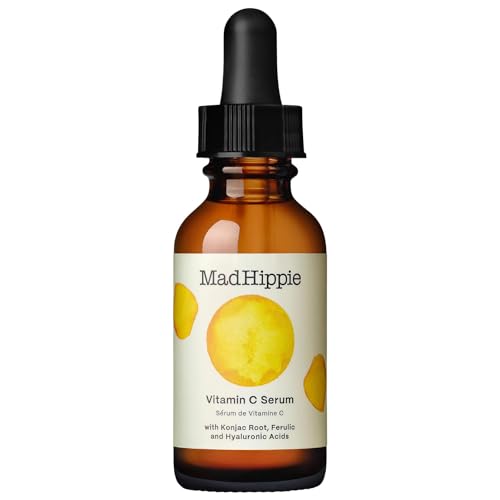
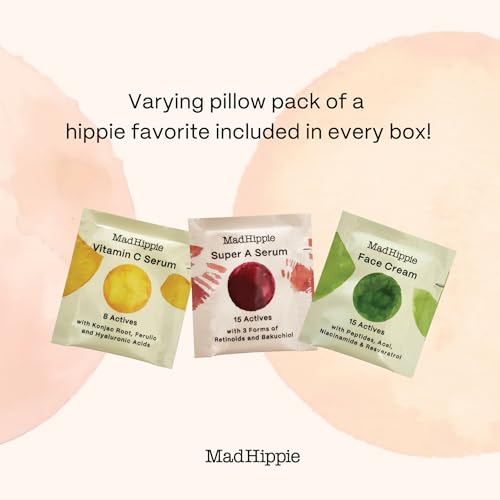
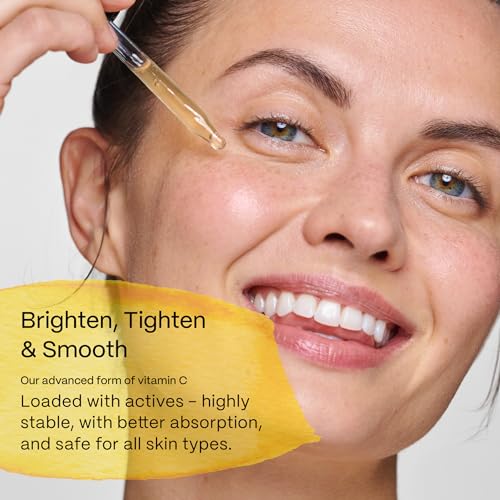
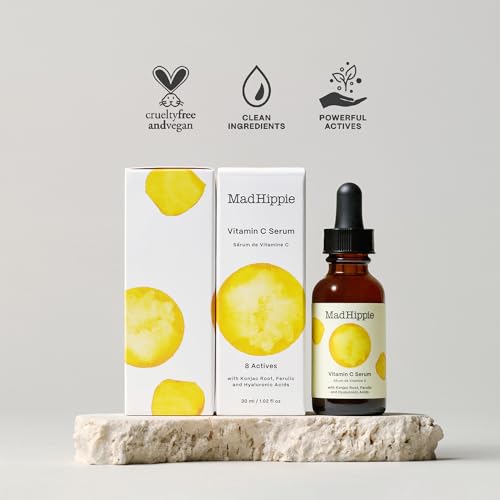
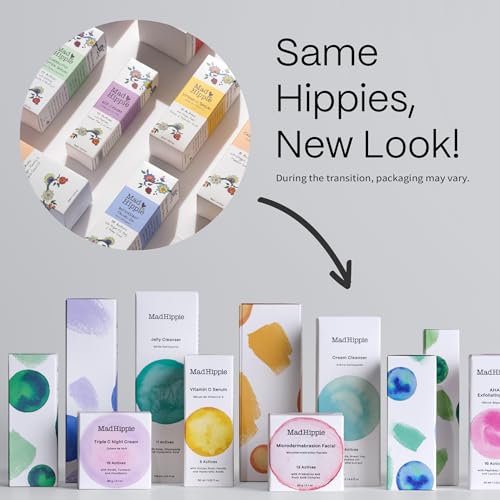
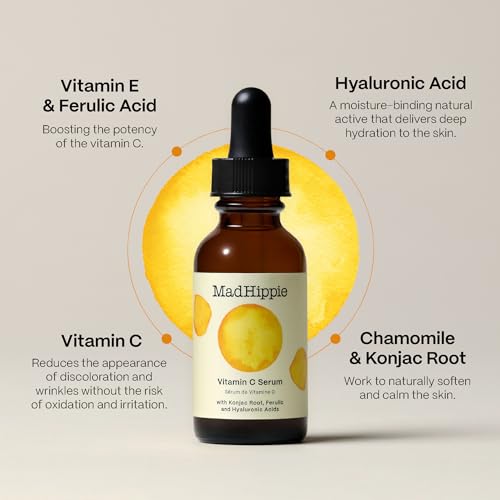
Mad Hippie Face Serum - Brightening with Vitamin C, Hyaluronic Acid & Antioxidants - 1.02 Fl Oz


Citrus Grandis (Grapefruit)
High RiskCitrus grandis (grapefruit) is a plant material commonly used in various products for its aromatic properties and potential skin benefits. It is often incorporated in cosmetics and personal care products for fragrance, antioxidant qualities, and as a natural preservative.
Sustai Insights
Citrus grandis offers functional benefits such as its antioxidant properties and natural fragrance, contributing positively to product formulations. However, it has a high allergenic potential, posing risks of skin and immunotoxic reactions. Environmental concerns include moderate persistence and bioaccumulation, raising ecotoxicity issues. Regulatory bodies have placed restrictions on its use in certain products, leading to an overall high-risk assessment. Safe usage practices are recommended, and alternatives like other citrus extracts or synthetic fragrances may be considered for reduced allergenic potential.
Ferulic Acid
Medium RiskFerulic acid is a phenolic compound primarily found in plant cell walls. It serves as an antioxidant in cosmetic and skincare products, protecting the skin from free radical damage and enhancing product stability.
Sustai Insights
Ferulic acid offers functional benefits as a potent antioxidant, contributing to skin protection and product efficacy. It is generally recognized as safe, with low concerns for carcinogenicity, allergies, and reproductive toxicity. However, moderate use restrictions exist, and its environmental impact is minimal. Regulatory bodies have not issued significant warnings. Overall, ferulic acid is associated with a medium risk level due to potential use restrictions, and safe usage practices should be adhered to. Alternative antioxidants may provide similar benefits.
Salvia Sclarea (Clary Sage) Oil
Medium RiskSalvia sclarea (clary sage) oil is a volatile oil obtained from the flowering tops of the clary sage plant. It is primarily used in aromatherapy and cosmetic products for its fragrance and potential therapeutic properties.
Sustai Insights
Clary sage oil offers functional benefits as a natural fragrance and is known for its calming effects in aromatherapy. It is not a carcinogen and has low developmental toxicity. However, it carries moderate allergenic potential and can cause irritation in sensitive individuals. While not considered a significant environmental pollutant, its production should be ethically sourced. Regulatory status is generally favorable, with no current restrictions by authorities like the FDA. Overall, the risks associated with clary sage oil are assessed to be medium, warranting cautious use.
Glycerin
Medium RiskGlycerin (also called glycerol) is a naturally occurring compound commonly used in personal care and cosmetic products. It functions as a humectant, attracting moisture to the skin, and is also utilized as a solvent and emollient to enhance product texture and stability.
Sustai Insights
Glycerin is valued for its effective moisturizing properties and biodegradability, making it a widely accepted ingredient in formulations. It poses low health risks, including low concerns for carcinogenicity and allergies. However, moderate use restrictions exist due to regulatory guidelines. While glycerin does not significantly contribute to environmental pollution, its production process should be ethically sourced. Overall, glycerin holds a medium risk level, emphasizing the importance of safe usage practices and considering sustainable alternatives.
Aloe Barbadensis (Aloe Vera)
Low RiskAloe barbadensis, commonly known as aloe vera, is derived from the succulent leaves of the aloe plant. It is widely used in cosmetic products for its soothing and moisturizing properties, often included for its potential skin benefits.
Sustai Insights
Aloe vera provides effective moisturizing and soothing benefits for the skin, supporting its use in various cosmetic formulations. It is generally considered safe, with low concerns for carcinogenicity, allergies, and reproductive toxicity. Regulatory bodies impose minimal restrictions, underlining its low-risk profile. While environmental impacts are minimal, its sustainability credentials depend on sourcing practices. Safe usage includes topical application, with no significant adverse effects reported. Alternatives exist, such as plant-based gels, but aloe vera remains a favored choice due to its low-risk assessment.
Ascorbic Acid (Vitamin C)
Low RiskAscorbic acid (Vitamin C) is a naturally occurring antioxidant essential for various biological functions, including collagen synthesis and immune response. It is commonly used in cosmetic and food products for its preservative properties and ability to enhance skin brightness.
Sustai Insights
Ascorbic acid provides functional benefits as an effective antioxidant and preservative, contributing to skin health and product stability. It is generally recognized as safe with low health risks, including minimal concerns for carcinogenicity and allergies. Environmentally, it poses low risks, as it is biodegradable and does not bioaccumulate. Regulatory bodies like the FDA have not imposed significant restrictions on its use. Overall, the ingredient presents a low risk, with safe usage practices ensuring consumer safety, and alternatives such as natural extracts exist for those seeking different formulations.
Sodium Levulinate
Low RiskSodium levulinate is the sodium salt of levulinic acid, primarily used as a preservative and antimicrobial agent in cosmetic and personal care products. It functions effectively in formulations to extend shelf life and prevent microbial growth.
Sustai Insights
Sodium levulinate is recognized for its functional benefits as a preservative with low health risks, including negligible potential for carcinogenicity, allergies, or reproductive toxicity. It is also considered environmentally friendly due to its low pollutant potential and biodegradability. Regulatory bodies have not imposed significant restrictions on its use. Overall, the risk associated with sodium levulinate is assessed as low, making it a suitable choice in various formulations.
Hydroxyethylcellulose
Low RiskHydroxyethylcellulose is a modified cellulose polymer used primarily as a thickening agent and stabilizer in various cosmetic and personal care products. It is soluble in water and helps to improve the texture and viscosity of formulations, enhancing their usability and performance.
Sustai Insights
Hydroxyethylcellulose offers functional benefits such as effective thickening and stabilization in formulations, contributing to product texture. It is generally considered low-risk in terms of health, with minimal concerns regarding carcinogenicity, allergens, or reproductive toxicity. Environmentally, it poses low risks and is not known to be bioaccumulative. Regulatory bodies have not imposed significant restrictions on its use. Safe practices include adhering to recommended concentrations, and while alternatives exist, hydroxyethylcellulose remains a low-risk ingredient overall.
Amorphophallus Konjac Root Powder
Low RiskAmorphophallus konjac root powder is a ground powder derived from the tuber of the Amorphophallus konjac plant. It is primarily used as a thickening agent, emulsifier, and dietary fiber in food products, cosmetics, and dietary supplements due to its gel-forming properties.
Sustai Insights
Amorphophallus konjac root powder serves as a thickening agent and dietary fiber, contributing to the texture and satiety of food products. It is biodegradable and sourced sustainably, with low health risks, including negligible concerns regarding carcinogenicity, allergies, and reproductive toxicity. Environmental impacts are minimal, and it is not currently subject to regulatory restrictions. Overall, it presents a low risk based on scientific consensus, making it a viable ingredient in various applications.
Sodium Phytate
Low RiskSodium phytate is a complex sodium salt of phytic acid, primarily used in cosmetic formulations as a chelating agent. It helps to stabilize formulations by binding metal ions, which can improve product efficacy and shelf life.
Sustai Insights
Sodium phytate offers functional benefits by enhancing product stability and is considered to have low health risks, with no significant associations with carcinogenicity, allergies, or reproductive toxicity. Environmentally, it poses minimal risks, as it is not considered a pollutant or bioaccumulative. Regulatory status indicates no significant restrictions. Overall, the ingredient is assessed as low risk. However, users should practice safe usage and consider alternatives like other chelating agents if desired.
C12 15 Alkyl Benzoate
Low RiskC12-15 alkyl benzoate comprises benzoic acid and long-chain alcohols. It is primarily used in cosmetic formulations as an emollient and solvent, enhancing product texture and stability while providing a light, non-greasy feel on the skin.
Sustai Insights
C12-15 alkyl benzoate offers functional benefits as a skin-conditioning agent and solvent, contributing to desirable product texture. It is considered low-risk for common health concerns such as cancer, allergies, and irritation. Environmentally, it poses minimal hazards, with no significant bioaccumulation or pollution potential. Regulatory bodies have not imposed notable restrictions, affirming its overall safety profile. Safe usage practices are advisable, particularly for sensitive populations. Alternatives may include naturally derived esters, providing similar benefits with potentially enhanced sustainability. Overall, the ingredient is assessed as low risk.
Anthemis Nobilis (Chamomile) Flower Extract
Low RiskAnthemis nobilis (chamomile) flower extract is derived from the flowers of the chamomile plant. It is commonly used in cosmetic and personal care products for its soothing properties and potential anti-inflammatory effects. Its role primarily centers around skin calming and providing a pleasant fragrance.
Sustai Insights
Chamomile extract offers functional benefits, particularly in soothing irritated skin and reducing inflammation. It is considered sustainably sourced and biodegradable. Health risks are minimal, with low concerns for carcinogenicity, allergies, and neurotoxicity. Environmental risks are also low, with no significant pollutant or bioaccumulation potential. Regulatory status indicates no major restrictions, affirming its safe use in cosmetics. Overall, this ingredient presents a low risk, making it a favorable choice in personal care formulations.
Sodium Anisate
Low RiskSodium anisate is the sodium salt of p-anisic acid, commonly used as a preservative in various cosmetic and personal care products. It is recognized for its antimicrobial properties, which help to extend the shelf life of products by inhibiting the growth of bacteria and fungi.
Sustai Insights
Sodium anisate serves effectively as a preservative, offering antimicrobial benefits while being biodegradable and potentially sustainably sourced. Health risks are low, with minimal concerns regarding carcinogenicity, allergies, or reproductive toxicity. Environmentally, it poses low risks as it is not bioaccumulative. Regulatory bodies, including the EPA, do not impose significant restrictions on its use. Overall, sodium anisate presents a low risk, making it a favorable choice in formulations, although alternatives should be considered for those seeking greener options.
Hyaluronic Acid
Low RiskHyaluronic acid is a natural polysaccharide found in connective tissues, skin, and cartilage, primarily serving as a moisture-retaining agent in cosmetic products. Its primary function is to provide hydration and improve skin elasticity, making it a common ingredient in moisturizers and serums.
Sustai Insights
Hyaluronic acid offers significant functional benefits, such as effective hydration and skin plumping, while being biodegradable and generally recognized as safe by regulatory bodies. Health risks are minimal, with low concerns regarding carcinogenicity, allergies, or reproductive toxicity. Environmental risks are also low, as it is not considered a pollutant or bioaccumulative. Regulatory bodies have not issued major advisories against its use, resulting in an overall low-risk assessment. For safe usage, it is recommended to apply in appropriate concentrations. Alternatives include glycerin or aloe vera, which also provide hydration.
Water
Low RiskWater is a clear, colorless liquid essential for various biological processes. It serves as a solvent in formulations, facilitating the dissolution of other ingredients and enhancing product texture and application. Additionally, water plays a crucial role in hydration and is a key component in many cosmetic and personal care products.
Sustai Insights
Water is an effective solvent and hydrator, contributing to the texture and efficacy of formulations. It is biodegradable and generally regarded as safe, with low concerns regarding carcinogenicity, allergies, and reproductive toxicity. However, excessive water usage can lead to environmental concerns, particularly regarding resource depletion. Regulatory bodies do not impose restrictions on water use in cosmetics. Overall, the risks associated with water are low, making it a safe and essential ingredient.
Tocopherol
Low RiskTocopherols are a class of naturally occurring compounds, primarily known for their role as antioxidants. They are commonly used in cosmetic and skincare products to help stabilize formulations and protect ingredients from oxidative damage.
Sustai Insights
Tocopherols provide functional benefits such as antioxidant protection and skin conditioning. They are generally recognized as safe, with low concerns regarding carcinogenicity, allergies, and reproductive toxicity. However, enhanced skin absorption and potential endocrine disruption are noted. Regulatory bodies have not imposed significant restrictions on tocopherols, categorizing the overall risk as low. Safe usage practices should be observed, and while alternatives exist, tocopherols remain a viable option in formulations.
Xanthan Gum
Low RiskXanthan gum is a polysaccharide, a sugar-based compound produced by the fermentation of glucose or sucrose. It is commonly used as a thickening agent and stabilizer in various food and cosmetic products due to its ability to improve texture and prevent ingredient separation.
Sustai Insights
Xanthan gum serves effectively as a thickener and stabilizer, enhancing product texture and consistency. It is biodegradable and typically derived from renewable sources, supporting sustainability efforts. Health risks are minimal, with low concerns regarding carcinogenicity, allergies, and reproductive toxicity. Environmental impact is similarly low, posing no significant hazards. Regulatory agencies, including the FDA, regard it as safe for use, with no significant restrictions. Overall, xanthan gum is assessed as low risk, making it a suitable ingredient in formulations.
Citrus Grandis (Grapefruit)
High RiskCitrus grandis (grapefruit) is a plant material commonly used in various products for its aromatic properties and potential skin benefits. It is often incorporated in cosmetics and personal care products for fragrance, antioxidant qualities, and as a natural preservative.
Sustai Insights
Citrus grandis offers functional benefits such as its antioxidant properties and natural fragrance, contributing positively to product formulations. However, it has a high allergenic potential, posing risks of skin and immunotoxic reactions. Environmental concerns include moderate persistence and bioaccumulation, raising ecotoxicity issues. Regulatory bodies have placed restrictions on its use in certain products, leading to an overall high-risk assessment. Safe usage practices are recommended, and alternatives like other citrus extracts or synthetic fragrances may be considered for reduced allergenic potential.
Aloe Barbadensis (Aloe Vera)
Low RiskAloe barbadensis, commonly known as aloe vera, is derived from the succulent leaves of the aloe plant. It is widely used in cosmetic products for its soothing and moisturizing properties, often included for its potential skin benefits.
Sustai Insights
Aloe vera provides effective moisturizing and soothing benefits for the skin, supporting its use in various cosmetic formulations. It is generally considered safe, with low concerns for carcinogenicity, allergies, and reproductive toxicity. Regulatory bodies impose minimal restrictions, underlining its low-risk profile. While environmental impacts are minimal, its sustainability credentials depend on sourcing practices. Safe usage includes topical application, with no significant adverse effects reported. Alternatives exist, such as plant-based gels, but aloe vera remains a favored choice due to its low-risk assessment.
Ascorbic Acid (Vitamin C)
Low RiskAscorbic acid (Vitamin C) is a naturally occurring antioxidant essential for various biological functions, including collagen synthesis and immune response. It is commonly used in cosmetic and food products for its preservative properties and ability to enhance skin brightness.
Sustai Insights
Ascorbic acid provides functional benefits as an effective antioxidant and preservative, contributing to skin health and product stability. It is generally recognized as safe with low health risks, including minimal concerns for carcinogenicity and allergies. Environmentally, it poses low risks, as it is biodegradable and does not bioaccumulate. Regulatory bodies like the FDA have not imposed significant restrictions on its use. Overall, the ingredient presents a low risk, with safe usage practices ensuring consumer safety, and alternatives such as natural extracts exist for those seeking different formulations.
Sodium Levulinate
Low RiskSodium levulinate is the sodium salt of levulinic acid, primarily used as a preservative and antimicrobial agent in cosmetic and personal care products. It functions effectively in formulations to extend shelf life and prevent microbial growth.
Sustai Insights
Sodium levulinate is recognized for its functional benefits as a preservative with low health risks, including negligible potential for carcinogenicity, allergies, or reproductive toxicity. It is also considered environmentally friendly due to its low pollutant potential and biodegradability. Regulatory bodies have not imposed significant restrictions on its use. Overall, the risk associated with sodium levulinate is assessed as low, making it a suitable choice in various formulations.
Ferulic Acid
Medium RiskFerulic acid is a phenolic compound primarily found in plant cell walls. It serves as an antioxidant in cosmetic and skincare products, protecting the skin from free radical damage and enhancing product stability.
Sustai Insights
Ferulic acid offers functional benefits as a potent antioxidant, contributing to skin protection and product efficacy. It is generally recognized as safe, with low concerns for carcinogenicity, allergies, and reproductive toxicity. However, moderate use restrictions exist, and its environmental impact is minimal. Regulatory bodies have not issued significant warnings. Overall, ferulic acid is associated with a medium risk level due to potential use restrictions, and safe usage practices should be adhered to. Alternative antioxidants may provide similar benefits.
Hydroxyethylcellulose
Low RiskHydroxyethylcellulose is a modified cellulose polymer used primarily as a thickening agent and stabilizer in various cosmetic and personal care products. It is soluble in water and helps to improve the texture and viscosity of formulations, enhancing their usability and performance.
Sustai Insights
Hydroxyethylcellulose offers functional benefits such as effective thickening and stabilization in formulations, contributing to product texture. It is generally considered low-risk in terms of health, with minimal concerns regarding carcinogenicity, allergens, or reproductive toxicity. Environmentally, it poses low risks and is not known to be bioaccumulative. Regulatory bodies have not imposed significant restrictions on its use. Safe practices include adhering to recommended concentrations, and while alternatives exist, hydroxyethylcellulose remains a low-risk ingredient overall.
Amorphophallus Konjac Root Powder
Low RiskAmorphophallus konjac root powder is a ground powder derived from the tuber of the Amorphophallus konjac plant. It is primarily used as a thickening agent, emulsifier, and dietary fiber in food products, cosmetics, and dietary supplements due to its gel-forming properties.
Sustai Insights
Amorphophallus konjac root powder serves as a thickening agent and dietary fiber, contributing to the texture and satiety of food products. It is biodegradable and sourced sustainably, with low health risks, including negligible concerns regarding carcinogenicity, allergies, and reproductive toxicity. Environmental impacts are minimal, and it is not currently subject to regulatory restrictions. Overall, it presents a low risk based on scientific consensus, making it a viable ingredient in various applications.
Sodium Phytate
Low RiskSodium phytate is a complex sodium salt of phytic acid, primarily used in cosmetic formulations as a chelating agent. It helps to stabilize formulations by binding metal ions, which can improve product efficacy and shelf life.
Sustai Insights
Sodium phytate offers functional benefits by enhancing product stability and is considered to have low health risks, with no significant associations with carcinogenicity, allergies, or reproductive toxicity. Environmentally, it poses minimal risks, as it is not considered a pollutant or bioaccumulative. Regulatory status indicates no significant restrictions. Overall, the ingredient is assessed as low risk. However, users should practice safe usage and consider alternatives like other chelating agents if desired.
Salvia Sclarea (Clary Sage) Oil
Medium RiskSalvia sclarea (clary sage) oil is a volatile oil obtained from the flowering tops of the clary sage plant. It is primarily used in aromatherapy and cosmetic products for its fragrance and potential therapeutic properties.
Sustai Insights
Clary sage oil offers functional benefits as a natural fragrance and is known for its calming effects in aromatherapy. It is not a carcinogen and has low developmental toxicity. However, it carries moderate allergenic potential and can cause irritation in sensitive individuals. While not considered a significant environmental pollutant, its production should be ethically sourced. Regulatory status is generally favorable, with no current restrictions by authorities like the FDA. Overall, the risks associated with clary sage oil are assessed to be medium, warranting cautious use.
C12 15 Alkyl Benzoate
Low RiskC12-15 alkyl benzoate comprises benzoic acid and long-chain alcohols. It is primarily used in cosmetic formulations as an emollient and solvent, enhancing product texture and stability while providing a light, non-greasy feel on the skin.
Sustai Insights
C12-15 alkyl benzoate offers functional benefits as a skin-conditioning agent and solvent, contributing to desirable product texture. It is considered low-risk for common health concerns such as cancer, allergies, and irritation. Environmentally, it poses minimal hazards, with no significant bioaccumulation or pollution potential. Regulatory bodies have not imposed notable restrictions, affirming its overall safety profile. Safe usage practices are advisable, particularly for sensitive populations. Alternatives may include naturally derived esters, providing similar benefits with potentially enhanced sustainability. Overall, the ingredient is assessed as low risk.
Anthemis Nobilis (Chamomile) Flower Extract
Low RiskAnthemis nobilis (chamomile) flower extract is derived from the flowers of the chamomile plant. It is commonly used in cosmetic and personal care products for its soothing properties and potential anti-inflammatory effects. Its role primarily centers around skin calming and providing a pleasant fragrance.
Sustai Insights
Chamomile extract offers functional benefits, particularly in soothing irritated skin and reducing inflammation. It is considered sustainably sourced and biodegradable. Health risks are minimal, with low concerns for carcinogenicity, allergies, and neurotoxicity. Environmental risks are also low, with no significant pollutant or bioaccumulation potential. Regulatory status indicates no major restrictions, affirming its safe use in cosmetics. Overall, this ingredient presents a low risk, making it a favorable choice in personal care formulations.
Sodium Anisate
Low RiskSodium anisate is the sodium salt of p-anisic acid, commonly used as a preservative in various cosmetic and personal care products. It is recognized for its antimicrobial properties, which help to extend the shelf life of products by inhibiting the growth of bacteria and fungi.
Sustai Insights
Sodium anisate serves effectively as a preservative, offering antimicrobial benefits while being biodegradable and potentially sustainably sourced. Health risks are low, with minimal concerns regarding carcinogenicity, allergies, or reproductive toxicity. Environmentally, it poses low risks as it is not bioaccumulative. Regulatory bodies, including the EPA, do not impose significant restrictions on its use. Overall, sodium anisate presents a low risk, making it a favorable choice in formulations, although alternatives should be considered for those seeking greener options.
Hyaluronic Acid
Low RiskHyaluronic acid is a natural polysaccharide found in connective tissues, skin, and cartilage, primarily serving as a moisture-retaining agent in cosmetic products. Its primary function is to provide hydration and improve skin elasticity, making it a common ingredient in moisturizers and serums.
Sustai Insights
Hyaluronic acid offers significant functional benefits, such as effective hydration and skin plumping, while being biodegradable and generally recognized as safe by regulatory bodies. Health risks are minimal, with low concerns regarding carcinogenicity, allergies, or reproductive toxicity. Environmental risks are also low, as it is not considered a pollutant or bioaccumulative. Regulatory bodies have not issued major advisories against its use, resulting in an overall low-risk assessment. For safe usage, it is recommended to apply in appropriate concentrations. Alternatives include glycerin or aloe vera, which also provide hydration.
Water
Low RiskWater is a clear, colorless liquid essential for various biological processes. It serves as a solvent in formulations, facilitating the dissolution of other ingredients and enhancing product texture and application. Additionally, water plays a crucial role in hydration and is a key component in many cosmetic and personal care products.
Sustai Insights
Water is an effective solvent and hydrator, contributing to the texture and efficacy of formulations. It is biodegradable and generally regarded as safe, with low concerns regarding carcinogenicity, allergies, and reproductive toxicity. However, excessive water usage can lead to environmental concerns, particularly regarding resource depletion. Regulatory bodies do not impose restrictions on water use in cosmetics. Overall, the risks associated with water are low, making it a safe and essential ingredient.
Glycerin
Medium RiskGlycerin (also called glycerol) is a naturally occurring compound commonly used in personal care and cosmetic products. It functions as a humectant, attracting moisture to the skin, and is also utilized as a solvent and emollient to enhance product texture and stability.
Sustai Insights
Glycerin is valued for its effective moisturizing properties and biodegradability, making it a widely accepted ingredient in formulations. It poses low health risks, including low concerns for carcinogenicity and allergies. However, moderate use restrictions exist due to regulatory guidelines. While glycerin does not significantly contribute to environmental pollution, its production process should be ethically sourced. Overall, glycerin holds a medium risk level, emphasizing the importance of safe usage practices and considering sustainable alternatives.
Tocopherol
Low RiskTocopherols are a class of naturally occurring compounds, primarily known for their role as antioxidants. They are commonly used in cosmetic and skincare products to help stabilize formulations and protect ingredients from oxidative damage.
Sustai Insights
Tocopherols provide functional benefits such as antioxidant protection and skin conditioning. They are generally recognized as safe, with low concerns regarding carcinogenicity, allergies, and reproductive toxicity. However, enhanced skin absorption and potential endocrine disruption are noted. Regulatory bodies have not imposed significant restrictions on tocopherols, categorizing the overall risk as low. Safe usage practices should be observed, and while alternatives exist, tocopherols remain a viable option in formulations.
Xanthan Gum
Low RiskXanthan gum is a polysaccharide, a sugar-based compound produced by the fermentation of glucose or sucrose. It is commonly used as a thickening agent and stabilizer in various food and cosmetic products due to its ability to improve texture and prevent ingredient separation.
Sustai Insights
Xanthan gum serves effectively as a thickener and stabilizer, enhancing product texture and consistency. It is biodegradable and typically derived from renewable sources, supporting sustainability efforts. Health risks are minimal, with low concerns regarding carcinogenicity, allergies, and reproductive toxicity. Environmental impact is similarly low, posing no significant hazards. Regulatory agencies, including the FDA, regard it as safe for use, with no significant restrictions. Overall, xanthan gum is assessed as low risk, making it a suitable ingredient in formulations.
Experience radiant skin with Mad Hippie Vitamin C Serum, a powerhouse blend designed for all skin types. This facial serum combines Vitamin C, Hyaluronic Acid, and Ferulic Acid to brighten, hydrate, and rejuvenate your complexion while being gentle on your skin.
- Brightening & Tightening: This award-winning serum helps improve skin texture by reducing fine lines, wrinkles, and dark spots, revealing a more youthful appearance.
- Hydration Boost: Infused with Hyaluronic Acid, it plumps the skin and retains moisture, making it perfect for dry or sun-damaged skin.
- Gentle Formula: Featuring a stable, non-oxidizing form of Vitamin C, it soothes without irritation, ideal for sensitive skin types.
- Ethical & Sustainable: Non-GMO, cruelty-free, and vegan, Mad Hippie is committed to harnessing the power of nature for beautiful skin while minimizing environmental impact.
- Easy Application: Simply cleanse, apply, and let absorb for glowing skin; integrate into your daily routine for optimal results.
Unlock your skin's potential with a serum that cares for both you and the planet.
Subscribe & Save with Sustai
- Best Price Guarantee: Always enjoy the lowest prices on sustainable home essentials.
- No Surprises: We’ll notify you before shipping. No hidden fees, ever.
- You’re in Charge: Change, pause, or cancel your subscription anytime with ease.
- Eco-Friendly Deliveries: Our grouped shipments mean less packaging and lower emissions.
Join us on a sustainable journey. Special offers for a limited time! Prices and promotions may change.
Recommended Products
Experience radiant skin with Mad Hippie Vitamin C Serum, a powerhouse blend designed for all skin types. This facial serum combines Vitamin C, Hyaluronic Acid, and Ferulic Acid to brighten, hydrate, and rejuvenate your complexion while being gentle on your skin.
- Brightening & Tightening: This award-winning serum helps improve skin texture by reducing fine lines, wrinkles, and dark spots, revealing a more youthful appearance.
- Hydration Boost: Infused with Hyaluronic Acid, it plumps the skin and retains moisture, making it perfect for dry or sun-damaged skin.
- Gentle Formula: Featuring a stable, non-oxidizing form of Vitamin C, it soothes without irritation, ideal for sensitive skin types.
- Ethical & Sustainable: Non-GMO, cruelty-free, and vegan, Mad Hippie is committed to harnessing the power of nature for beautiful skin while minimizing environmental impact.
- Easy Application: Simply cleanse, apply, and let absorb for glowing skin; integrate into your daily routine for optimal results.
Unlock your skin's potential with a serum that cares for both you and the planet.

You can have at most 2 Sustainable Steals products in your cart
Customer Reviews
Customers’ View
Customers appreciate the effectiveness and eco-friendly nature of this face serum. Many report significant improvements in skin health, noting a brighter, more radiant complexion and reduced dullness. Users frequently mention the gentle, non-irritating formula, with one customer stating, "my face feels brighter after a little over a week of use." The lightweight texture is also well-received, with comments highlighting its easy application and quick absorption. Additionally, the serum's natural ingredients align with health-conscious values, as it is non-GMO, cruelty-free, and vegan. While some customers have mixed opinions about its moisture level for dry skin, overall sentiment reflects satisfaction with the product's performance and value for money. Overall, customers find this serum effective and aligned with their sustainable lifestyle.
AI-generated from the text of customer reviewsThis product is rated 4.9 of 5.0 stars.
It has received 22 reviews.





